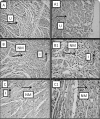Cardioprotective activity of flax lignan concentrate extracted from seeds of Linum usitatissimum in isoprenalin induced myocardial necrosis in rats
- PMID: 21753905
- PMCID: PMC3131680
- DOI: 10.2478/v10102-011-0016-8
Cardioprotective activity of flax lignan concentrate extracted from seeds of Linum usitatissimum in isoprenalin induced myocardial necrosis in rats
Abstract
The objective of the study was to evaluate the cardioprotective activity of flax lignan concentrate (FLC) in isoprenalin (ISO) induced cardiotoxicity in rats. Male Wistar rats (200-230 g) were divided into three groups. Group I: control, Group II: isoprenalin, Group III: FLC (500 mg/kg, p.o.) orally for 8 days and in group II and III isoprenalin 5.25 mg/kg, s.c. on day 9 and 8.5 mg/kg on day 10. On day 10 estimation of marker enzymes in serum and haemodynamic parameters were recorded. Animals were sacrificed, histology of heart was performed. Isoprenalin showed cardiotoxicity, manifested by increased levels of marker enzymes and increased heart rate. FLC treatment reversed these biochemical changes significantly compared with ISO group. The cardiotoxic effect of isoprenalin was less in FLC pretreated animals, which was confirmed in histopathological alterations. Haemodynamic, biochemical alteration and histopathological results suggest a cardioprotective protective effect of FLC in isoprenalin induced cardiotoxicity.
Keywords: Linum usitatissimum; flax lignan concentrate; flaxseed; isoprenalin; myocardial necrosis.
Figures


Similar articles
-
Flax lignan concentrate reverses alterations in blood pressure, left ventricular functions, lipid profile and antioxidant status in DOCA-salt induced renal hypertension in rats.Ren Fail. 2016;38(3):411-23. doi: 10.3109/0886022X.2015.1136895. Epub 2016 Jan 22. Ren Fail. 2016. PMID: 26795298
-
Omega-3-fatty acid adds to the protective effect of flax lignan concentrate in pressure overload-induced myocardial hypertrophy in rats via modulation of oxidative stress and apoptosis.Int Immunopharmacol. 2015 Sep;28(1):751-63. doi: 10.1016/j.intimp.2015.08.005. Epub 2015 Aug 14. Int Immunopharmacol. 2015. PMID: 26277701
-
Isolation, characterization and antihyperlipidemic activity of secoisolariciresinol diglucoside in poloxamer-407-induced experimental hyperlipidemia.Pharm Biol. 2014 Sep;52(9):1094-103. doi: 10.3109/13880209.2013.877492. Epub 2014 Mar 20. Pharm Biol. 2014. PMID: 24649910
-
Flaxseed and cardiovascular health.J Cardiovasc Pharmacol. 2009 Nov;54(5):369-77. doi: 10.1097/FJC.0b013e3181af04e5. J Cardiovasc Pharmacol. 2009. PMID: 19568181 Review.
-
Importance of Flaxseed and its Components in the Management of Hypertension.Int J Angiol. 2019 Sep;28(3):153-160. doi: 10.1055/s-0039-1678691. Epub 2019 Feb 22. Int J Angiol. 2019. PMID: 31452582 Free PMC article. Review.
Cited by
-
UPLC-HRMS Analysis Revealed the Differential Accumulation of Antioxidant and Anti-Aging Lignans and Neolignans in In Vitro Cultures of Linum usitatissimum L.Front Plant Sci. 2020 Sep 23;11:508658. doi: 10.3389/fpls.2020.508658. eCollection 2020. Front Plant Sci. 2020. PMID: 33072140 Free PMC article.
-
Medicinal plants with potential anti-arthritic activity.J Intercult Ethnopharmacol. 2015 Apr-Jun;4(2):147-79. doi: 10.5455/jice.20150313021918. Epub 2015 Mar 14. J Intercult Ethnopharmacol. 2015. PMID: 26401403 Free PMC article.
-
Therapeutic and Nutraceutical Effects of Polyphenolics from Natural Sources.Molecules. 2022 Sep 22;27(19):6225. doi: 10.3390/molecules27196225. Molecules. 2022. PMID: 36234762 Free PMC article. Review.
-
Recovery of biomolecules from food wastes--a review.Molecules. 2014 Sep 17;19(9):14821-42. doi: 10.3390/molecules190914821. Molecules. 2014. PMID: 25232705 Free PMC article. Review.
-
Current Advances in the Use of Nanophytomedicine Therapies for Human Cardiovascular Diseases.Int J Nanomedicine. 2021 May 11;16:3293-3315. doi: 10.2147/IJN.S295508. eCollection 2021. Int J Nanomedicine. 2021. PMID: 34007178 Free PMC article. Review.
References
-
- Baroldi G. Myocardial necrosis: the need for definition. J Mol Cell Cardiol. 1974;6:401–2. - PubMed
-
- Burton KP, McCord JM, Ghai G. Myocardial alteration due to free radical generation. Am J Physiol. 1984;84:H776–83. - PubMed
-
- Charlet S, Bensaddek L, Raynaud S, Gillet F, Mesnard F, Fliniaux MA. An HPLC procedure for the quantification of anhydrosecoisolariciresinol: application to the evaluation of flax lignan content. Plant Physiol Biochem. 2002;40:225–229.
LinkOut - more resources
Full Text Sources
